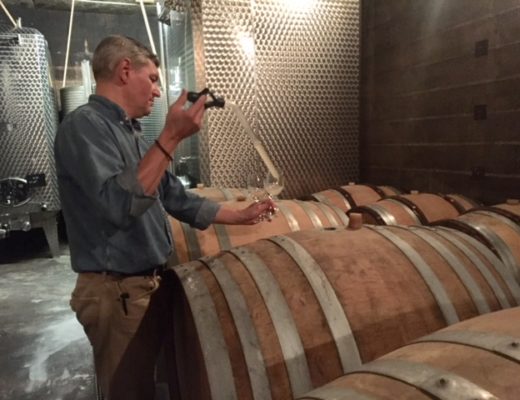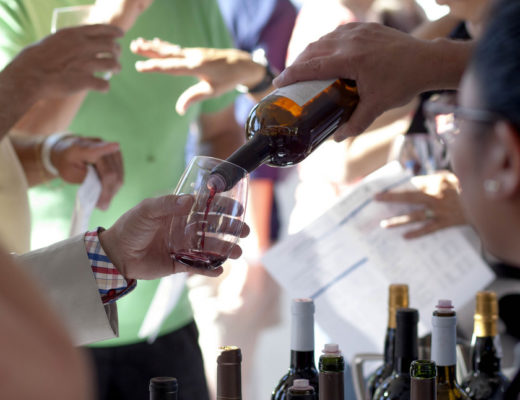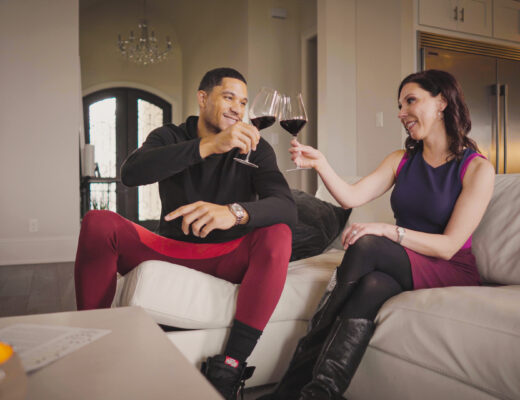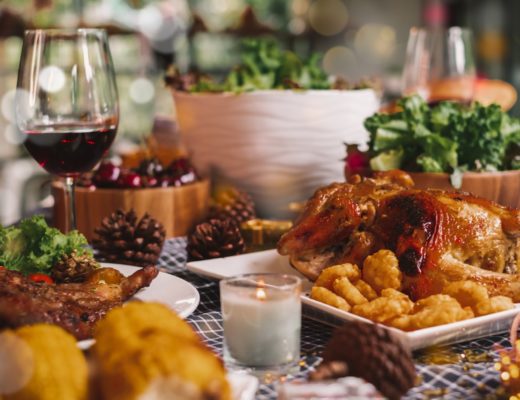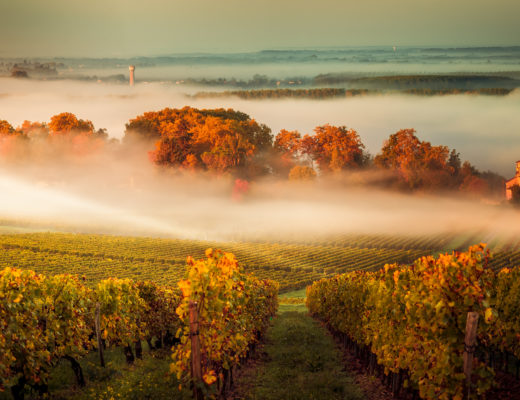This summer, we headed to Southern France for a visit to our favorite Rhône and Provençal wineries during the peak of rosé season. Despite Europe’s record-breaking heatwave, we couldn’t resist enjoying even the boldest, fullest reds of Châteauneuf-du-Pape. Along the way, we met Alain Pascal of Wine Access favorite estate Gros Noré, the heir to Domaine Tempier, and a pair of Wine Access enthusiasts on their own vinous adventure.
Read on for the full travelogue, and a sneak peek at wines headed to your inbox in the coming months.
Day 1: Misadventure en France
Our flight wasn’t turbulent, but our arrival in France was bumpy. Air France lost our luggage, and our connecting flight turned out to be a train (Surprise! They book trains now.) We ran to catch it, to discover the train was three hours late—meaning we wouldn’t be able to get our rental car. We needed to find a wine bar and fast.
When we finally arrived in Avignon, we discovered we were arriving during the city’s annual theater festival. Posters were festooned across the city for the annual festival, which we examined while exploring near our hotel in the old town. After a late, al fresco dinner on the square, we toasted to starting our adventure…and prayed our luggage would arrive in the morning.
Day 2: Seeing Provence through Rosé-Colored Lenses
When we awoke, Avignon was teeming with people visiting for the theater festival, and we hopped in the car and headed south to Provence.
Château Demoiselles, a 5-star Wine Access favorite, is a charming B&B and thoroughly modern winery in the d’Esclans valley, where rosé is a perfect accompaniment to postcard-perfect views. Underneath an azure blue sky, the Demoiselles Château was everything we imagined and more—to our left and right stretched rows of vines rooted in brick-red soils of clay and limestone, poor but well-draining. The southern sun was beating down hot, but relieved by the brisk, cooling gusts of the Mistral. It’s no wonder the Esclans Valley makes some of the world’s greatest roses.
Château des Demoiselles is not only located in rosé’s best-known region, but embodies everything that makes rosé a summertime standard. When temperatures start to rise, it’s exactly the kind of bottle you want to be lifting out of the ice bucket during happy hour.
After a morning at Demoiselles, we moved on to Château Saint Roseline, a much larger operation based in a former monastery. Roseline is one of the most visited spots in Provence, with an excellent tasting room and friendly staff, but their biggest attraction is the chapel itself.
On entering the Chapelle Sainte-Rosaline, it takes a moment for the eyes to adjust from the blindingly bright Provençal sun outside to the cool, dark interior of the Romanesque church. Beneath famed works by Chagall and Giacometti lies the preserved, 690-year-old mummy of Roseline de Villeneuve, a local hero and saint who brought about miracles and aided the poor. It’s the fist time we’ve ever been asked, “How do you feel about mummies?” when visiting a winery.
The monks originally set up shop on the property because of the natural springs that gave them easy access to water, but it is prime terroir for grapes too—one of the 23 properties singled out in the classification of Cotes de Provence. The Cinsault, Grenache, Cabernet Sauvignon, and Mourvèdre grapes grown outside the chapel the Teillaud family are terrifically expressive, offering delicate raspberry and melon aromas echoed on the lush palate, and tempered clean, bright freshness.
We inquired about something light for dinner and were recommended a small wine bar in Aix en Provence called Les Vieux Tonneau, not far from the Palais du Justice, or town hall. Most of the tables were al fresco, and we dined on local cheeses, sardines, jamon Iberique, and enjoyed a local Viognier and a Chateauneuf du Pape Blanc, happy to have experienced a gorgeous day in Provence…one so gorgeous we almost forgot we were still without our luggage.
Day 3: Allstars of Châteauneuf-du-Pape
We practically leaped from the hotel in anticipation of Châteauneuf Day!
We headed off to Château de Beaucastel. The grounds were an utterly breathtaking garden surrounding a collection of old stone buildings. The property is 240 contiguous acres that used to belong to the king, who eventually granted it to the Beaucastel family, purchased by the Perrin family in 1909.
We walked the vineyards, full of galets roulés, or smooth round stones that are a trademark of Châteauneuf-du-Pape terroir. The stones, which cover sandy loam over limestone, prevent evaporation of the water table in the heat, and then re-radiate that heat overnight, which aids in the ripening of the grapes. All of the vines were old and gnarled, especially the Mourvedre and Rousanne which average 60 years old.
The winery is old-school, with ancient cement fermentation vessels (lined with ceramic tile for ease of cleaning) and old foudres for aging, with some hogsheads and barriques for the Syrah and Mourvedre (they like more oxygen). Each year, Beaucastel holds back 10% of their production in the caves beneath the property, with back vintages and large format bottlings that would make any wine lover drool.
For lunch we headed to the village of Châteauneuf-du-Papes itself, to see the old castle. They road up to the castle is not well marked, a one-lane dirt road winding precariously up a tall hill, but it’s worth it if you love history or wine. Only a few of the walls survive, and it is truly a ruin, but affords a beautiful panoramic of the entire appellation. A short walk from the castle was a restaurant that came highly recommended called Au Vin Chambre, where we dined on Magret de Canard and Trout en Feuille accompanied by a local white—and were reminded that it’s hard to go wrong with food and wine in France.
Next, we headed to CDP’s other icon: Vieux Telegraphe. The property was originally planted in 1891 by the Brunier family (who still own it) as a grower of grapes, though they eventually became a winery with the successive generation, and is now one of the premier producers in the area.
The entire cellar is decorated with artwork and sculptures on a rotating basis, doubling as a gallery. After tasting through their line up and bonding with the tasting room manager (a proud American living her dream in the south of France), we asked about the vineyard. Her answer was perfect: “It’s just down the road, and you can see the old telegraph tower the winery is named for on the property. You can actually climb up it—no one will stop you.”
With that invitation, we set off to find it. After a few false turns, we climbed the three-story tower, and from the top you can get a glimpse of the slope and terroir that make the La Crau vineyard, the backbone of their property and their first vineyard, so very special.
With daydreams of La Crau top of mind, we tumbled back to reality when we discovered our hotel was out of electricity, and we weren’t allowed in. The heatwave was oppressive, so we wandered briefly before finding a friendly restaurant with wifi and air conditioning. Dinner at Restaurant 46 in Avignon—classic French seafood—was refreshing and delicious, and a welcome distraction from the lack of light, and lack of luggage we were still enduring.
Day 4: Surprises in Bandol and Beyond
Waking up to no hot water from the power outage the night before was bracing. Over breakfast, we discovered our appointments in the Southern Rhone having canceled on us unexpectedly. So we hopped in the car to head to Bandol, with hopes of visiting the producers of some of our favorite rustic reds and roses.
We have long been fans of Gros Nore, but didn’t have an appointment. Google said they were open, so we set the GPS and didn’t think twice. After a 2 hour drive, we arrived around noon. Their bucolic stone farmhouse winery seemed abandoned when we arrived, but, you know, Google, so we poked around to figure out where to go.
A strong, wizened looking grey-haired gentleman with a crooked nose soon popped his head out the door, looking confused. It was Alain Pascal, the owner and winemaker. He politely explained in French they were eating lunch, and if we wanted to taste we should come back around 2pm, because winemakers never rush at lunch. We decided to explore and grab some lunch ourselves in Saint-Cyr-sur-Mer, the closest village, and return to taste their wines.
Saint-Cyr-sur-Mer is beautiful town that commands an epic view of the landscape and the Mediterranean. We wandered the town agape, looking at menus, before we found a brilliant little restaurant down an alley–Restaruant Le Regain. Starting with Chevre wrapped in Prosciutto, then Andouillete Sausage and Pommes Frittes and roasted Durrand with Vegetables, all washed down with a stunning Bandol rosé.
The clouds parted on our mood as we sat down at one of the giant farm tables in the tasting room and chatted up some strangers.
Turns out they were Americans, too, and we were intrigued by their presence at the spectacular-yet-underrated Gros ‘Noré—it’s one of our favorite producers, but seemed a little out of the way for a family of tourists.
“We’re absolutely in love with their wines,” the woman told us, which they order from what she called “this great website…” At that precise moment, the scene went into super slo-mo, as she formed the words that would make everything about our trip—the weather woes, the lost clothes, and the travel tribulations—totally, completely, 100% worth it.
“…called Wine Access.”
We raised our glasses and gave a cheers so hearty that it almost shattered the stemware. Then we escorted our new friends up to where Alain was pouring, introduced ourselves (through Alain’s wife, who speaks English), and bonded over a bottle of the 2016 Bandol Rouge.
Afterward, we took a brief drive to Domaine Tempier, again without an appointment, and were greeted warmly. After watching the woman behind the counter haggle with the British man in front of us about why he can’t just buy their top bottlings, because, you know, they don’t make that much, we introduced ourselves and asked to learn more about the property.
Turns out we asked the right person. Veronique, as we learned her name was, is the great-granddaughter of the founder (who started the estate in 1834!). She explained that there are 6 villages in Bandol, their label is devoted to the village of Castelet, with its unique thin clay-loam topsoil over limestone rich in ancient fossils, that provided the requisite water and acid structure respectively to their wines in this warm region (It was HOT that day). She told us of the history of Bandol as a shipbuilding city for the royal navy, hence the ship on the label. The rich tannic reds of the region were also uniquely suited to survive travel, and thus built their reputation over time.
Traveling to our next hotel in Valence, on our way to the Northern Rhône for the next day’s adventures, we stopped of in Gigondas to see a wine bar and MW friend had raved about – Nez! Bar au Vin. Gigondas was an equally scenic village to the one we visited for lunch, only with the Dentelles de Montmirail behind it, mountains that stick out of the local foliage like giant teeth. From the city square you could see much of the southern Rhone highlighted in vespertine light. Still a bit balmy, we sat outside and dined on Sardines and Pulpe Galicienes, making sure to leave room for an excellent CDP.
Day 5: Hiking the Hill of Hermitage
On checkout, our lost luggage was finally returned!
We started the day at Paul Jaboulet Aîne, outside Tain l’Hermitage. Founded in 1834, they were purchased by the Frey family in 2006, who built a gorgeous warehouse-sized winery to update the production of the winery to be capable of merging the best of traditional and modern oenology.
We then left to tour the vineyard sites in Hermitage. All of Hermitage is on one giant, contiguous hill split geologically, offering differing aspects and soils. We stopped first at la Maison Blue in the west, named for the storehouse in its center with blue shutters. Then to La Meal, the site on the hill with a 45 degree slope and a gigantic “Paul Jaboulet Aîne” sign—a relic of advertising to rich Parisians that would vacation in the Midi in the mid 20th century. And finally to La Chappelle, the crown jewel of their property, that literally sits at the Hermitage on the very top of the hill that Gaspard de Sterenberg converted from a dilapidated Roman temple to Hercules to his retirement home from worldly life in 1224. Isn’t history fun?
But it is seriously prime terroir, and worth seeking out—the road is barely marked, but anyone can drive up there for a glorious view that encompasses almost every appellation in the Northern Rhône. But, maybe don’t do it when it’s over 100 degrees outside. Despite being conscientious about hydration, several of our party began feeling faint, and we decided to return to PJA’s wine bar in Tain l’Hermitage. There we tasted through their entire line up of wines, including some back vintages, while dining on ceviche, veal, and cod with roasted potatoes and vegetables.
After a long day, to conclude our stay in the Rhone we spent a night at the Cour des Loges in Layon, a beautifully appointed hotel in the old town, about a 15-minute walk from the old Roman amphitheater and Cathedral. We caught up on our correspondences and notes over a roasted chicken with pan jus at Le Café Épicerie, before getting ready for the next leg of our journey in Bordeaux.

